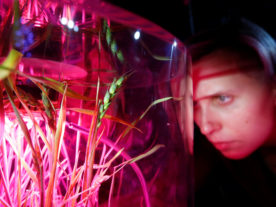Hot Monster Planet Found Orbiting Small Star
British astronomers say they discovered a “monster” planet orbiting a tiny star, but, according to planet formation theory, the planet should not even exist.
The theory suggests a planet of its size could not be formed around such a small star.
Located about 600 light years from Earth, the planet, dubbed NGTS-1b, is a gas giant and classified as a ‘hot Jupiter’ which means it’s physically similar to our solar system’s biggest planet, but is much hotter since it orbits its sun from a close distance.
The astronomers say NGTS-1b circles its star so closely that it’s just 3% of the distance Earth is to the Sun.
One year on the planet only lasts 2.6 Earth days.
While the planet may be large, its host star is small with half the radius and mass of our own sun.

Pretty park fountain, but it’s not the fountain of youth. (Marcus Quigmire/Creative Commons 2.0 via Flickr)
Sorry, No Fountain of Youth
Ancient legend has it that somewhere in this world there is a magic Fountain of Youth whose waters contain restorative powers that make old people young again.
A number of adventurers, including the 16th-century Spanish explorer Ponce De Leon, have searched for the mythical fountain.
Now, a new study from the University of Arizona says ‘sorry folks it’s just not out there’.
Joanna Mazel, a professor at the university and one of the two study authors says aging is unavoidable. The researchers found getting old is logically, theoretically and mathematically inevitable.
Mazel says current understanding of evolution does leave open a small chance that aging could be stopped.
But, to do so, she says science will need to come up with a way to make a selection between organisms perfect and at this time that’s something that isn’t that simple to do.

In a photo taken by Kyodo on 10/11/17, the Shinmoe volcano in Kirishima, Kagoshima Prefecture, Japan is seen after erupting. (Kyodo via Reuters)
Distant Volcanic Eruptions Help Melt Ice Sheets
When volcanoes erupt they blast huge amounts of gas, and dust particles into the atmosphere.
Scientists say the dust and gas reflect sunlight away from the Earth causing a cooling effect.
A new study by researchers at Columbia University suggests volcanic eruptions can also worsen the melting of our planet’s ice sheets.
The researchers say they found evidence volcanic eruptions quickly caused severe melting of the ice sheet that blanketed a good part of northern Europe toward the end of the last ice age between 12 and 13 thousand years ago.
The study notes that in some cases, the erupting volcanoes were located a thousand or more miles away.
The surface of the ice sheet was darkened by the falling volcanic ash, which allowed it to absorb more solar heat than usual.

This illustration shows exoplanet Kepler-13Ab that circles very close to its host star, Kepler-13A. On the nighttime side, the planet’s immense gravity pulls down titanium oxide, which falls as snow. (NASA, ESA, and G. Bacon (STScI))
It’s Snowing Sunscreen on Distant Exoplanet
Pennsylvania State University astronomers, studying Hubble Space Telescope observations, found that it snows titanium oxide on half of the hot exoplanet Kepler 13ab.
Titanium oxide is one of the key active ingredients in sunscreen.
Kepler 13ab, a hot Jupiter exoplanet, is part of a multiple star system with at least 3 solar components and is located some 1,730 light-years from Earth.
The exoplanet is tidally locked to its primary star, Kepler 13a, which means it has a permanent day and a night side, like the moon, is with Earth.
The titanium oxide ‘snow’ was found to be falling on the night side of the planet.
The astronomers say Kepler 13ab orbits its primary star so closely that the dayside of the exoplanet is about 2,760 degrees Celsius.























Comments are closed.